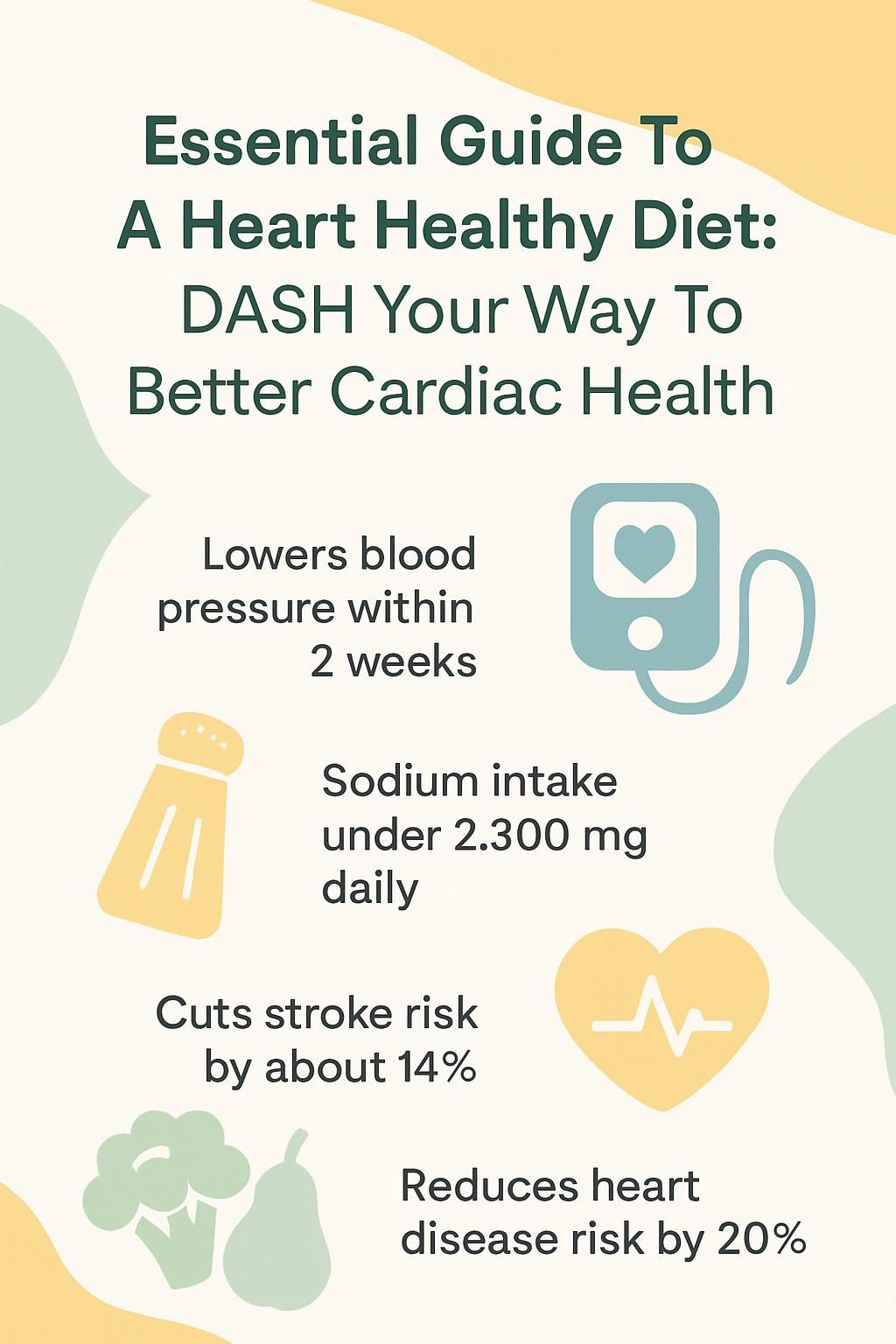Essential Guide To A Heart Healthy Diet: DASH Your Way To Better Cardiac Health
Our Nutrition Assistant AI Suite will transform your body. You will lose fat, get toned, and build muscle. Gain confidence and optimal health.
If you worry about your heart and feel lost in mixed advice, you are not alone. I felt that way too. Heart disease is still the top cause of death in the United States, which pushed me to find solid answers. This guide explains the DASH eating plan, short for Dietary Approaches to Stop Hypertension. You will see how small daily choices, like more fruits and vegetables and less sodium, can support a heart-healthy diet and better heart health.
I share clear steps you can use right away. The goal is steady, realistic change that lasts.
Key Takeaways
- The DASH diet, supported by the NIH and CDC, can lower blood pressure in about two weeks. It centers on fruits, vegetables, whole grains, lean proteins, and limited sodium.
- The American Heart Association recommends less than 2,300 mg sodium per day and under 6% of calories from saturated fat to reduce heart disease risk.
- Choosing fewer processed foods and more whole foods may lower cholesterol and cut stroke risk by about 14% in major studies.
- Regular movement adds to the diet’s benefits. The guideline is at least 150 minutes of moderate aerobic activity each week.
- Sticking with DASH-style eating may lower the risk of heart disease or stroke by up to 20% over ten years, based on 2023 AHA data.

Overview of heart health and the importance of diet.
Food choices shape heart health. Patterns that favor fruits, vegetables, whole grains, lean proteins like fish or poultry, and healthy fats from olive oil or nuts help prevent heart disease, stroke, and high blood pressure.
Limiting sodium and saturated fat lowers the chance of a heart attack. Extra calories lead to weight gain, which strains the circulatory system. I look for the AHA Heart-Check mark to spot products that meet strong nutrition standards.
Research shows that an overall eating plan matters more than any single treat. Next, I explain how the DASH diet fits this big-picture approach.
Introduction to the DASH diet and its purpose.
DASH stands for Dietary Approaches to Stop Hypertension. Hypertension means high blood pressure. This plan lowers blood pressure and helps protect against heart attack and stroke. The NIH and CDC both endorse it as an effective approach to better heart health.
Sodium makes the body hold onto fluid, which can raise blood pressure. DASH limits sodium and promotes smart portions. It also encourages more fruits and vegetables, whole grains, lean proteins like fish or beans, and low-fat or fat-free dairy. Highly processed foods, which are often high in sugar and saturated fat, are limited.
These ideas align with current dietary guidelines. Now, here is what the DASH pattern includes.
What is the DASH Diet?

DASH, or Dietary Approaches to Stop Hypertension, is a structured eating plan that can help lower your blood pressure. It is a practical path to heart-healthy eating and steady progress.
Explanation of DASH (Dietary Approaches to Stop Hypertension).
DASH was developed in the 1990s with support from U.S. health agencies. The goal was simple, use food to reduce blood pressure. The plan highlights fruits, vegetables, whole grains, lean meats, fish, low-fat or fat-free dairy, nuts, beans, and seeds. It also guides people to cut back on sodium, saturated fat, and added sugars.
Studies show blood pressure can improve within two weeks. Many people also see lower LDL cholesterol, the type linked to plaque in arteries. I felt more energy when I swapped salty snacks and refined grains for fresh produce and whole grains.
Historical background and development of the diet.
NIH-funded research in the 1990s showed that targeted food patterns could lower blood pressure, even without medication. Medical experts built the DASH plan from those findings to reduce major risks such as excess salt and high LDL cholesterol.
The American Heart Association and leading clinics continue to recommend DASH. Reviews in recent years confirm that its core ideas still match current needs. The focus stays on produce, whole grains, lean protein, and healthy fats that protect arteries and support heart health.
Core Principles of the DASH Diet
The DASH diet gives me a clear daily map. Small steps add up, like filling half my plate with colorful produce.
Emphasis on fruits and vegetables.
Fruits and vegetables supply fiber, vitamins, and minerals with few calories. That mix helps lower the risk of heart disease. The American Heart Association suggests 4 to 5 servings of each group per day.
I keep ready-to-eat carrots and grapes in sight, so they are an easy choice. Filling half your plate with colorful produce can help protect against heart disease,
says nutrition expert Dr. Lisa Young.
Higher intake is linked with lower blood pressure and better cholesterol levels. That means a lower chance of coronary artery disease and heart attack. Choose salads with light vinaigrette, and skip creamy dressings or sugary toppings.
Inclusion of whole grains, lean proteins, and healthy fats.
At least half of my grains come from whole sources such as brown rice, oats, and 100% whole-wheat bread. Whole grains add fiber that helps lower LDL cholesterol and keep me full.
For protein, I choose skinless chicken or turkey, fish like salmon or mackerel, and plant proteins such as beans and lentils. These options keep saturated fat in check. For healthy fats, I cook with olive or canola oil and snack on a small handful of nuts or seeds.
Limiting sodium, sugars, and saturated fats.
Managing these three makes a big difference. The AHA suggests less than 2,300 mg of sodium per day. Many people do even better at 1,500 mg. I watch for hidden sodium in canned soups, sauces, and snacks.
I cap added sugars at under 10% of daily calories, about 50 grams on a 2,000-calorie plan. I also keep saturated fat under 6% of calories, about 11 to 13 grams a day for most adults. That means fewer high-fat meats and full-fat dairy and more heart-healthy swaps.
| Nutrient | Daily target | Why it matters |
|---|---|---|
| Sodium | 1,500 to 2,300 mg | Helps lower blood pressure |
| Added sugars | Under 10% of calories | Supports weight and heart health |
| Saturated fat | Under 6% of calories | Helps reduce LDL cholesterol |
Health Benefits of the DASH Diet
Think of DASH as a steady tailwind for your heart. The plan supports lower blood pressure, healthier cholesterol, and fewer cardiovascular events.
Reducing blood pressure.
DASH is rich in potassium, calcium, and magnesium, minerals that relax blood vessels. Cutting sodium to 1,500 milligrams or less can lower both top and bottom blood pressure numbers. This is especially helpful for people with a history of high blood pressure.
I focus on leafy greens, bananas, beans, yogurt, and whole grains. Choosing fresh foods over processed ones helped my readings improve within weeks.
Lowering cholesterol levels.
Replacing saturated and trans fats with unsaturated fats can lower LDL cholesterol. I use olive oil instead of butter and add ground flaxseed to oatmeal for extra omega-3 fatty acids. These are heart-friendly fats that research links to better cholesterol patterns.
Fruits, vegetables, and whole grains also add soluble fiber. Fiber binds some cholesterol in the gut and carries it out of the body.
Decreasing the risk of heart disease and stroke.
Better blood pressure and healthier cholesterol, together, reduce strain on arteries. DASH also cuts back on sodium and processed food, which supports more flexible blood vessels. That means a lower chance of plaque buildup, heart attack, and stroke.
I swapped many packaged snacks for nuts, fruit, and whole grains. Those changes made it easier to manage my weight and keep my risk lower.
Foods to Include in Your DASH Diet
Build your plate with nutrient-dense options. These foods deliver fiber, minerals, and healthy fats that help prevent heart disease.
Recommended servings of fruits and vegetables.
The AHA suggests 4 to 5 servings each of fruits and vegetables daily. One serving equals one medium fruit, half a cup of cooked vegetables, or one cup of raw leafy greens. Fresh is great, and frozen or low-sodium canned options also work.
If I buy canned fruit, I choose 100% juice or water. I often cover half my plate with produce at lunch and dinner. It boosts fiber and helps control blood pressure.
Whole grains options and their benefits.
Choose whole-wheat flour and bread, cereals with at least 5 grams of fiber per serving, brown rice, barley, buckwheat, and whole-grain pasta. These choices support a heart-healthy diet and help keep LDL cholesterol in range.
Switching from white rice to brown rice or barley keeps me satisfied longer. Research links higher whole grain intake with lower stroke risk, around 14% in some large studies.
Healthy protein sources (lean meats, fish, legumes).
I pick lean meats and trim any visible fat. Fish such as salmon, trout, and mackerel provide omega-3 fatty acids that lower triglycerides. Legumes including beans, peas, and lentils add protein and fiber with little fat.
Replacing red meat with fish or legumes can help lower heart disease risk. These foods also add key minerals without extra sodium.
Foods to Avoid on the DASH Diet
Some items make it harder to control blood pressure and cholesterol. Keeping them in check supports steady progress.
High-sodium items to limit.
Regular table salt, canned soups, frozen meals, and salty condiments add up fast. Soy sauce, ketchup, pickles, and many salad dressings are common sources. Restaurant meals often run high in sodium as well.
I used to rely on frozen dinners on busy nights. Some had over 1,200 mg of sodium per serving, more than half the daily limit. Reading labels helped me swap in lower sodium choices and cook simple batches at home.
Sugary snacks and processed foods.
Many packaged snacks, pastries, and sweetened products contain added sugars and unhealthy fats. I scan labels for syrups and sugar names. The guideline is less than 10% of daily calories from added sugar, which is no more than 50 grams on a 2,000-calorie plan.
Food processing often removes fiber and adds refined starches. I aim for whole foods most of the time to support steady energy and healthy blood sugar.
Saturated and trans fats.
Saturated and trans fats raise LDL cholesterol. I replace butter, lard, cream sauces, and hydrogenated oils with olive or canola oil. I also check labels for partially hydrogenated oils, a sign of trans fat, in packaged snacks.
Choosing nuts, seeds, and fish adds monounsaturated and polyunsaturated fats that are better for the heart. I prefer low-fat or fat-free dairy instead of cream-based products.
Tips for Following the DASH Diet
I rely on a few simple habits to make this eating plan stick. These steps reduce guesswork and keep my heart-healthy goals on track.
Meal planning and preparation advice.
I plan meals around vegetables, fruits, whole grains, lean proteins, and healthy fats like nuts and olive oil. Measuring spoons and a food scale help me learn true portions for rice and cooking oil.
Research shows that portion awareness can reduce sodium intake by a meaningful amount. I rotate recipes for variety, such as baked salmon with quinoa one night and a lentil and vegetable stew another night.
On busy weeks, I prep produce and proteins in advance. Chopping greens and onions once saves time later and helps me skip processed options that are high in sodium and saturated fat.
Making healthier choices when dining out.
I avoid all-you-can-eat deals and skip large size upgrades. Sharing an entree helps with portions. Choosing a side salad instead of fries adds more fruits and vegetables to the meal.
For social events, I bring a vegetable dish so a heart-healthy option is available. Simple swaps help too, like grilled fish instead of fried meat and water or unsweetened tea instead of sugary drinks.
Incorporating physical activity alongside dietary changes.
Movement makes the diet work even better. The AHA suggests at least 150 minutes per week of moderate aerobic activity or 75 minutes of vigorous activity.
I take brisk walks after meals and do short strength sessions at home. Regular activity supports healthy blood pressure and cholesterol. It also helps the body use minerals like potassium and magnesium from food.
Adjusting the DASH Diet for Personal Needs
I tailor the plan to my health goals and daily routine. Small, targeted changes make it easier to stay consistent.
Modifying the diet for weight loss goals.
For weight loss, I create a small calorie deficit while protecting nutrition. Smaller plates and bowls help with portions. High-fiber foods, such as vegetables, fruit, legumes, and whole grains, keep me full on fewer calories.
I choose lean protein to support muscles and plan snacks, like a small handful of nuts or yogurt, with care. Keeping sodium modest reduces water retention and helps me feel comfortable.
Tailoring the DASH diet for specific health conditions (e.g., diabetes).
For diabetes, I focus on steady blood sugar. Plant proteins, including legumes, tofu, and nuts, tend to be lower in saturated fat and contain no cholesterol. I also limit refined grains and added sugars.
Choosing whole fruit over juice helps me manage glucose and appetite. Many people find these changes also support heart health markers.
Challenges of Adopting the DASH Diet
Change takes effort, especially at first. With practice and planning, the plan becomes routine.
Common obstacles individuals face.
Many store and restaurant foods are loaded with sodium and unhealthy fats. Social events can make it hard to pass on salty snacks and desserts. Portion sizes can be confusing too.
Vegetarian choices can be limited at some gatherings. Busy schedules can push people toward quick, high-sodium meals. These hurdles are common and normal.
Strategies to overcome these challenges.
I read Nutrition Facts panels and ingredient lists to find better options. The AHA’s Healthy for Good resources offer recipes and tips I can use right away. I set a weekly plan so grocery trips are faster and more focused.
I swap salty ingredients for herbs, citrus, garlic, and salt-free spice blends. At meals, half my plate is produce and whole grains replace refined choices. Small steps, repeated daily, add up to lasting heart-healthy habits.
Conclusion
Good information turns into better heart health when it is used often. Trusted sources like the NIH and American Heart Association can guide your next steps. This article is educational and not medical advice. Talk with your clinician for personal guidance, especially if you have chronic conditions or take medications.
Recap of key points.
DASH is a heart-healthy eating plan built on fruits, vegetables, whole grains, lean proteins, and low sodium. Keeping saturated fat under 6% of calories and added sugar under 10% supports healthy cholesterol and weight. These habits work together to help lower blood pressure and protect your heart.
Encouragement to adopt heart-healthy habits for a better quality of life.
A few daily choices can shift your long-term risk in a positive way. AHA data from 2023 suggests that following a DASH-style pattern may reduce heart disease and stroke risk by up to 20% over ten years. I felt real benefits by choosing whole grains, fresh produce, and regular movement.
Sleep well, manage stress, and avoid tobacco. If you start small and stay steady, a heart-healthy diet becomes second nature. Your heart, and your future, are worth it.
FAQs
1. What is the DASH diet and how does it support cardiac health?
The DASH diet is an eating plan designed to lower blood pressure and improve heart health. It focuses on fruits, vegetables, whole grains, lean proteins, and low-fat dairy while limiting sodium, added sugars, and saturated fats. Studies show that people who follow this eating plan often see reduced blood pressure levels and a lower risk of heart disease.
2. Which foods should I include in a heart healthy diet based on the DASH approach?
A heart healthy diet includes plenty of fresh produce like leafy greens and berries; whole grains such as brown rice or oatmeal; lean meats like chicken or fish; nuts; seeds; beans; and low-fat dairy products. Limiting processed foods helps reduce sodium intake which supports better cardiac health.
3. How much sodium does the DASH eating plan recommend for better cardiac outcomes?
The standard DASH eating plan suggests no more than 2,300 milligrams of sodium per day with an ideal target closer to 1,500 milligrams for those at higher risk of high blood pressure or cardiovascular problems. Research links lower sodium intake with improved blood vessel function.
4. Can you share a personal experience using the DASH diet as an eating plan?
After my doctor recommended the DASH approach due to family history of hypertension I started planning meals around its guidelines by choosing more vegetables at each meal swapping white bread for whole grain options and cooking with herbs instead of salt within weeks my energy improved My next checkup showed healthier numbers which reinforced my commitment
Summary: The DASH diet is an evidence-based eating plan proven to help manage blood pressure through specific food choices including fruits vegetables whole grains lean protein sources nuts seeds beans low-fat dairy while reducing sodium This structured approach can lead to measurable improvements in cardiac health







